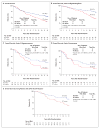Radiation plus Procarbazine, CCNU, and Vincristine in Low-Grade Glioma
- PMID: 27050206
- PMCID: PMC5170873
- DOI: 10.1056/NEJMoa1500925
Radiation plus Procarbazine, CCNU, and Vincristine in Low-Grade Glioma
Abstract
Background: Grade 2 gliomas occur most commonly in young adults and cause progressive neurologic deterioration and premature death. Early results of this trial showed that treatment with procarbazine, lomustine (also called CCNU), and vincristine after radiation therapy at the time of initial diagnosis resulted in longer progression-free survival, but not overall survival, than radiation therapy alone. We now report the long-term results.
Methods: We included patients with grade 2 astrocytoma, oligoastrocytoma, or oligodendroglioma who were younger than 40 years of age and had undergone subtotal resection or biopsy or who were 40 years of age or older and had undergone biopsy or resection of any of the tumor. Patients were stratified according to age, histologic findings, Karnofsky performance-status score, and presence or absence of contrast enhancement on preoperative images. Patients were randomly assigned to radiation therapy alone or to radiation therapy followed by six cycles of combination chemotherapy.
Results: A total of 251 eligible patients were enrolled from 1998 through 2002. The median follow-up was 11.9 years; 55% of the patients died. Patients who received radiation therapy plus chemotherapy had longer median overall survival than did those who received radiation therapy alone (13.3 vs. 7.8 years; hazard ratio for death, 0.59; P=0.003). The rate of progression-free survival at 10 years was 51% in the group that received radiation therapy plus chemotherapy versus 21% in the group that received radiation therapy alone; the corresponding rates of overall survival at 10 years were 60% and 40%. A Cox model identified receipt of radiation therapy plus chemotherapy and histologic findings of oligodendroglioma as favorable prognostic variables for both progression-free and overall survival.
Conclusions: In a cohort of patients with grade 2 glioma who were younger than 40 years of age and had undergone subtotal tumor resection or who were 40 years of age or older, progression-free survival and overall survival were longer among those who received combination chemotherapy in addition to radiation therapy than among those who received radiation therapy alone. (Funded by the National Cancer Institute and others; ClinicalTrials.gov number, NCT00003375.).
Figures



Comment in
-
Brain cancer: Chemoradiotherapy for low-grade glioma: battle won, but the war goes on.Nat Rev Clin Oncol. 2016 Jun;13(6):328-9. doi: 10.1038/nrclinonc.2016.61. Epub 2016 Apr 19. Nat Rev Clin Oncol. 2016. PMID: 27092955 No abstract available.
-
Radiation plus Chemotherapy in Low-Grade Glioma.N Engl J Med. 2016 Aug 4;375(5):490-1. doi: 10.1056/NEJMc1605897. N Engl J Med. 2016. PMID: 27518677 No abstract available.
-
Radiation plus Chemotherapy in Low-Grade Glioma.N Engl J Med. 2016 Aug 4;375(5):489-90. doi: 10.1056/NEJMc1605897. N Engl J Med. 2016. PMID: 27518678 No abstract available.
-
Radiation plus Chemotherapy in Low-Grade Glioma.N Engl J Med. 2016 Aug 4;375(5):490. doi: 10.1056/NEJMc1605897. N Engl J Med. 2016. PMID: 27518679 No abstract available.
-
A Randomized Clinical Trial of Radiation With or Without Chemotherapy for Low-grade Gliomas.Neurosurgery. 2016 Oct;79(4):N17-8. doi: 10.1227/01.neu.0000499709.51090.ea. Neurosurgery. 2016. PMID: 27635971 No abstract available.
-
Treatment of Gliomas: A Changing Landscape.Int J Radiat Oncol Biol Phys. 2017 Jun 1;98(2):255-258. doi: 10.1016/j.ijrobp.2017.02.223. Int J Radiat Oncol Biol Phys. 2017. PMID: 29941232 No abstract available.
References
-
- Cairncross G, Macdonald D, Ludwin S, et al. Chemotherapy for anaplastic oligodendroglioma. J Clin Oncol. 1994;12:2013–21. - PubMed
-
- Buckner JC, Brown LD, Kugler JW, et al. Phase II evaluation of recombinant interferon alpha and BCNU in recurrent glioma. J Neurosurg. 1995;82:430–5. - PubMed
-
- Galanis E, Buckner JC, Burch PA, et al. Phase II trial of nitrogen mustard, vincristine, and procarbazine in patients with recurrent glioma: North Central Cancer Treatment Group results. J Clin Oncol. 1998;16:2953–8. - PubMed
-
- Mason WP, Krol GS, DeAngelis LM. Low-grade oligodendroglioma responds to chemotherapy. Neurology. 1996;46:203–7. - PubMed
-
- Buckner JC, Gesme D, Jr, O’Fallon JR, et al. Phase II trial of procarbazine, lomustine, and vincristine as initial therapy for patients with low-grade oligodendroglioma or oligoastrocytoma: efficacy and associations with chromosomal abnormalities. J Clin Oncol. 2003;21:251–5. - PubMed
Publication types
MeSH terms
Substances
Associated data
Grants and funding
- U10 CA180868/CA/NCI NIH HHS/United States
- R01 CA188228/CA/NCI NIH HHS/United States
- 1RC2CA148190/CA/NCI NIH HHS/United States
- UG1 CA189867/CA/NCI NIH HHS/United States
- 1R01CA169368/CA/NCI NIH HHS/United States
- R01CA108633/CA/NCI NIH HHS/United States
- U10 CA180835/CA/NCI NIH HHS/United States
- R01 CA108633/CA/NCI NIH HHS/United States
- RC2 CA148190/CA/NCI NIH HHS/United States
- U10 CA21661/CA/NCI NIH HHS/United States
- U10 CA180850/CA/NCI NIH HHS/United States
- R01 CA169368/CA/NCI NIH HHS/United States
- NRG-BN-TS002/BN/FDA HHS/United States
- U10 CA37422/CA/NCI NIH HHS/United States
- P30 CA022453/CA/NCI NIH HHS/United States
- U10 CA037422/CA/NCI NIH HHS/United States
- U10 CA021661/CA/NCI NIH HHS/United States
- U10 CA25224/CA/NCI NIH HHS/United States
- R01 CA140314/CA/NCI NIH HHS/United States
- U10 CA025224/CA/NCI NIH HHS/United States
- U10 CA180822/CA/NCI NIH HHS/United States
LinkOut - more resources
Full Text Sources
Other Literature Sources
Medical
